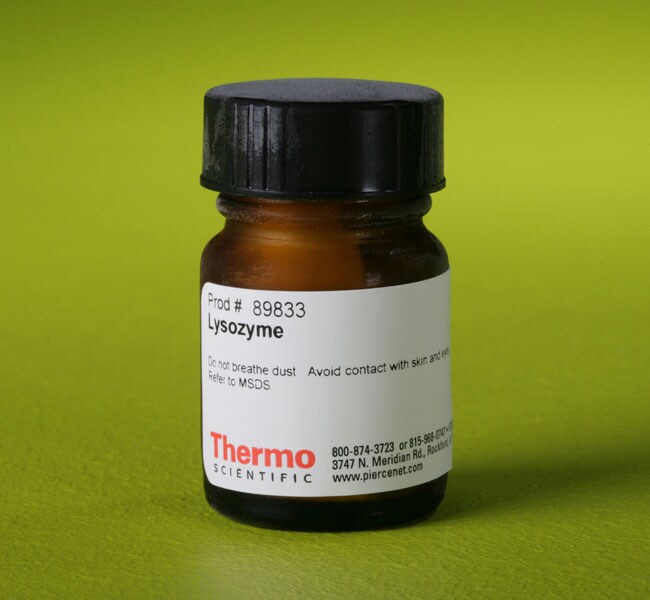Specifications:
| Application | molecular biology | ||
| Storage Temperature | -20°C | ||
| Product Type | Molecular Biology Reagent | Forms | lyophilized powder |
| Product Brand | Thermo Fisher Scientific™ | ||
| Product Grade | Molecular Biology | ||
The Thermo Scientific™ Lysozyme is a highly purified enzyme characterized by its ability to efficiently lyse bacterial cell walls, improving the extraction of proteins and nucleic acids. Provided as a lyophilized powder, this enzyme is ideal for large-volume applications in molecular biology and biochemistry research.
Key Features:
- High Enzymatic Activity:
- Activity: Approximately 20,000 units/mg dry weight, delivering reliable and consistent lysis results.
- Efficiently hydrolyzes peptidoglycan in bacterial cell walls, targeting 1,4-β-linkages between N-acetylmuramic acid and N-acetyl-D-glucosamine residues.
- Versatile Applications:
- Facilitates the lysis of Gram-positive bacteria and improves the lysis of Gram-negative bacteria (e.g., E. coli, Salmonella, Shigella) when combined with nucleases like DNase I.
- Suitable for inclusion body purification by digesting cellular debris and releasing inclusion bodies for downstream analysis.
- High Purity and Solubility:
- Supplied as a white, lyophilized powder.
- Readily soluble at 5 mg/mL in 0.1M KH₂PO₄, producing a clear, colorless solution for ease of use.
- Broad Compatibility:
- Works seamlessly with Thermo Scientific Pierce Cell Lysis Reagents.
- Compatible with downstream protein purification workflows, such as affinity purification for fusion-tagged recombinant proteins.
- Stable and Convenient:
- Long shelf life when stored at -20°C in a non-frost-free freezer.
- Shipped on ice to preserve enzymatic activity during transit.
Applications:
- Protein Extraction:
- Breaks down bacterial cell walls to release soluble proteins for research and industrial purposes.
- Nucleic Acid Extraction:
- Enhances the yield of high-quality DNA and RNA from bacterial cells for genomic and transcriptomic studies.
- Inclusion Body Purification:
- Efficiently digests cellular debris to isolate inclusion bodies for recombinant protein studies.
- Biochemical Research:
- Studies enzymatic interactions with bacterial cell walls.
- Supports structural and functional analysis of bacterial peptidoglycan.
Specifications:
| Feature | Details |
|---|---|
| Product Type | Cell Lysis Enzyme |
| Form | Lyophilized Powder |
| Enzyme | Lysozyme (Muramidase) |
| Activity | ~20,000 units/mg dry weight |
| Molecular Weight | 14.388 kDa |
| Extinction Coefficient | ~26.4 at 280 nm |
| Isoelectric Point | pH 11.0 |
| Solubility | Soluble at 5 mg/mL in 0.1M KH₂PO₄ |
| Storage Conditions | -20°C (non-frost-free freezer) |
| Quantity | 5 g |
Unit Definition:
One unit is defined as the amount of enzyme required to catalyze a decrease in absorbance at 450 nm of 0.001/min at 25°C, pH 6.24, using a ~0.25 mg/mL suspension of Micrococcus luteus.
Advantages:
- High Efficiency:
- Quickly lyses bacterial cells, significantly improving protein and nucleic acid extraction efficiency.
- Convenience:
- Lyophilized powder format allows for easy preparation and storage.
- Soluble and compatible with various buffers and workflows.
- Broad Application Range:
- Suitable for both research-scale and large-volume applications in molecular biology, microbiology, and biochemistry.
- Reliability:
- Manufactured under strict quality controls to ensure consistent performance.
Usage Instructions:
- Dissolve the lyophilized powder in an appropriate buffer (e.g., 0.1M KH₂PO₄) at the desired concentration.
- Add the solution to the bacterial suspension and incubate under optimal conditions for cell lysis.
- Proceed with downstream applications, such as protein purification or nucleic acid isolation.
Related Products:
- Lysozyme Solution (50 mg/mL) for ready-to-use cell lysis.
- Thermo Scientific Pierce Cell Lysis Reagents for optimized protein extraction workflows.
The Thermo Scientific™ Lysozyme (Lyophilized Powder, 5 g) offers a reliable, high-activity solution for bacterial cell lysis and biomolecule extraction. Its compatibility with large-volume applications and downstream workflows makes it an indispensable tool for research laboratories and industrial use.




 0
0
